 |
||
|
Nafplio: A Cosmopolitan Tale
|
||
|
Statues, buildings and monuments recount this living museum's rich history. A classical music festival provides the town's score
By Christy Papadopoulou Athens News TRAVERSING the lush Argolid past olive groves, poppy fields and orange blossoms, you reach the city of Nafplio, the first capital of the independent Greek state. In the shadow of a rocky peninsula near the head of the Argolid Gulf, Nafplio is a popular destination for travellers who use the town as a springboard for daily trips to the well-advertised archaeological sites of Mycenae, Tiryns and Asine. For many, though, their relationship with Napoli di Romania, or Anapli, as the place was named by the Venetians, is less transient. |
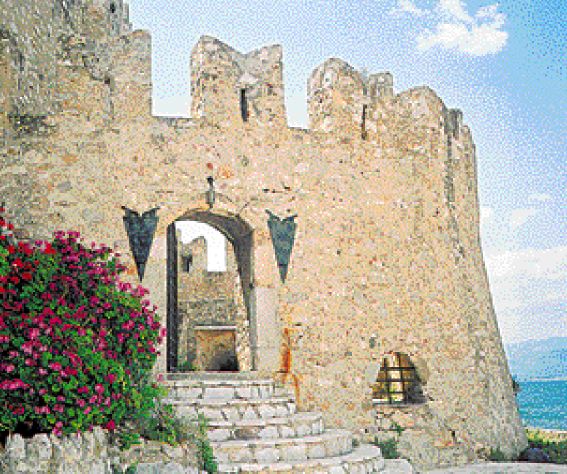 The back entrance to Bourdzi, once a retreat for public executioners now a music venue |
|
| A two-and-a-half-hour drive from Athens is all it takes for a journey through history. Once past Nafplio's modern town, a typical suburb with dull apartment buildings of concrete, the scenery changes dramatically - for the better. Time seems to stall here as the pace of life slows down. Appointments are set loosely at the central marble-paved Constitution (Syntagmatos) Square, known to the locals as 'the platanos square' in honour of the perennial plane tree whose thick foliage is the hospitable alternative to the coffeeshop umbrellas. Warm, uncompromising smiles bid farewell to wrinkled foreheads and in a mute conspiracy four-wheeled vehicles are sent on a sabbatical, at least for short-distance routes, with bicycles taking over. Amid this leisurely atmosphere, walking is the best way to explore the town which has a story to tell every turn you take. |
||
| A stroll in time It is often the town's statues, buildings and monuments that take up the role of storyteller. A sculpture of the so-called Geros tou Moria, Kolokotronis, on horseback points to the fortress of Palamidi. We plan our visit there for later on in the day when the sun fades to allow the steep ascent of the legendary 999 steps to the entrance of the fortress. Dikastirion Square, where the bus terminus lies, is a convenient starting point to reach the old town. A marble statue of Ioannis Capodistrias, who in 1828 resigned his post as Russia's foreign minister to become the first Greek president, gazes in that direction. |
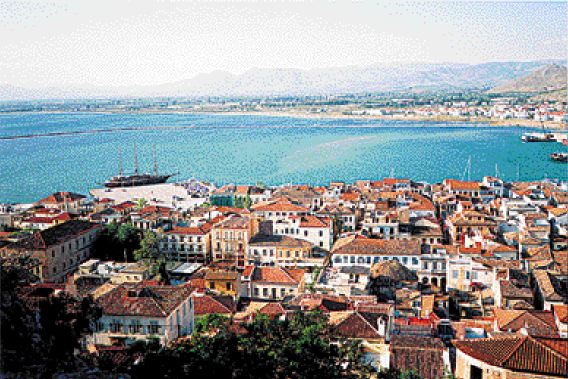 A bird's-eye view of the old town of Nafplio |
|
| The first high school to operate in liberated Greece under his presidency and the first Nafplio pharmacy belonging to Boniface Bonafin, who undertook the embalming of Capodistrias' body following his assassination three years after, are both to be found at Trion Navarhon Square at the entrance of the old town. The mark from the bullet which terminated Capodistrias' life and with it the progress of the fledging Greek state can be seen at the junction of Plapouta and Angelos Terzakis streets to the right of the door of the three-century-old Agios Spyridon Church where Capodistrias faced his death. Strolling through labyrinthine streets and alleys, the modern day visitor is impressed by the architectural wealth of Neoclassicism and Eclecticism for which Nafplio is famous. There is a harmonious mix of stately homes in the shade of their proud palm trees bearing the grandeur of bygone days with bougainvillea-crowned stone-built buildings and Turkish fountains. Landmark buildings stand unthreatened by the touristy taverns, coffeeshops and Plaka-style souvenir shops which were the result of Nafplio's evolution into a holiday resort. The town has become a living museum with a cosmopolitan air. One of these monumental edifices above the Agios Spyridon Square is Fragoklisia, now Metamorphosi tou Sotiros, which served as a place of worship for both the Venetians and the Ottomans. On the central Constitution Square there are also the Venetian Arsenale with its splendid arcade (used as barracks before housing the Nafplio Archaeological Museum in 1930), the large mosque known as Vouleftiko (which housed the first Greek Parliament) and a smaller mosque now named Trianon (now a venue for cultural events). A turbulent history Little is known of Nafplio's ancient history, save mention of its harbour in Euripides' play Orestes as the place where Menelaos disembarked on his return from Troy before reaching Argos. Pausanias makes reference to Kanathos, a spring in Nafplia in whose waters Hera used to bathe on her wedding anniversary so that she could regain her virginity. |
||
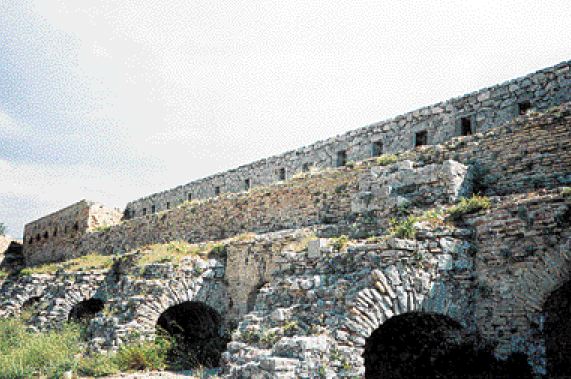 Constructed during the second Venetian |rule, Palamidi was in its day a model of military engineering |
In Byzantine times and before its siege by the Franks in 1212 Nafplio developed into an important administrative and commercial centre, thanks to its strategic position and its fortification which left it untouched by pirate attacks. In its later history, from 1389 onwards, Nafplio underwent two Venetian and two Ottoman rules. During the first Venetian rule which lasted 150 years (1389-1540) it grew into one of the most prosperous cities in the East. It was at that time that Bourdzi, a castle on a small islet just off the coast, was erected. A picture of the city during the first Ottoman rule (1540-1686) survives through the memoirs and drawings of the first foreign travellers who reached the city in the late 16th century. |
|
The chief undertaking of the second Venetian rule (1686-1715) during which Nafplio was declared capital of the Kingdom of Morea was the fortress of Palamidi, at the time a model of military engineering. During the second Ottoman rule (1715-1822) and with the construction of mosques and Turkish baths, Nafplio shed its European aura. Following Capodistrias' assassination in 1831, Nafplio was governed by King Otto up until 1834, when the Greek capital was moved to Athens. With much of Nafplio's history of bloody conflicts written around its fortifications, a visit to its three castles - Bourdzi, Akronafplia and Palamidi - is a must. Our trip coincided with the Historic Acropolis Rally of vintage cars, so we were lucky to find room on one of the caiques (there is a frequent service in the summer months) that take visitors to the Renaissance construction. Built in 1471 on the Agii Theodori Islet by the military engineer Brancaleone, the fortress, which served in 19th century as a retreat for the public executioners in the Palamidi prison before its current use as a cultural venue, offers a panoramic view of Palamidi and Akronafplia. |
||
| Rocky Akronafplia (also known by its Turkish name Its Kale) - which comprises three towers, Greek, Frankish and Venetian - can be reached from Arvanitia, where the Xenia Hotel is situated. Attractions here include the Arvanitia seaside promenade against the backdrop of a cliffy landscape 'embroidered' with prickly pears, the famous clock of Nafplio and the Venetian emblem of St Mark's winged lion at Akronafplia's east bastion. In one of its many variations, the Lion of St Mark also marks the entrance to the Agios Andreas bastion - one of Palamidi's eight, including the largest one where Kolokotronis was imprisoned. The impregnable fortress that was the stronghold of Greek freedom fighters during the War of Independence can be reached either through a 45-minute climb of stairs (best in the early morning or late afternoon) that lead to its west side or by car (or taxi) from its east side. |
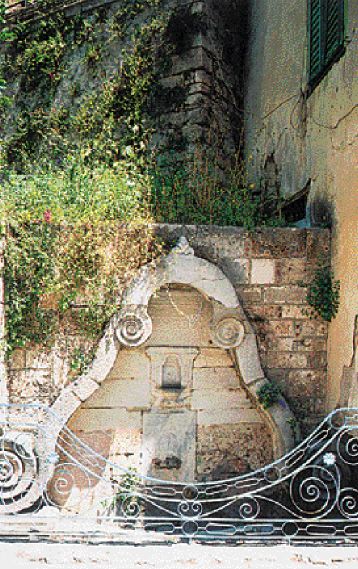 A Turkish fountain in Nafplio's old town |
|
| Museum crawl Apart form its actual monuments, Nafplio boasts a variety of museums. Nafplio's war museum features exhibits - weapons, photographs and archive material - from different periods in modern Greek history from the War of Independence and the Asia Minor campaign to World War II and the German Occupation. It was originally the first academy for officers of the Greek army back in 1828. Among the exhibits is a pen, a watch and two pages of manuscript text by Nafplio-born author Angelos Terzakis, who served during World War II as corporal in the first regiment of heavy artillery. Honoured in 1981 with the European Museum of the Year Award, the Vassilios Papantoniou's Peloponnesian Folklore Foundation gathers under the same roof folk costumes, bridal and christening outfits, textiles, jewellery and domestic items such as sewing machines, wooden chests and cradle cots. On display there is a travelling chest and a collection of hats belonging to poet laureate George Seferis, two 19th-century labour chairs from the Argolid and a 'pilafi blanket' from wool and goat hair. Traditionally, such a blanket would be woven collectively on an improvised loom by a bride and her friends, who would throw rice and almonds at the bride as they wove to wish her happiness in her married life. |
||
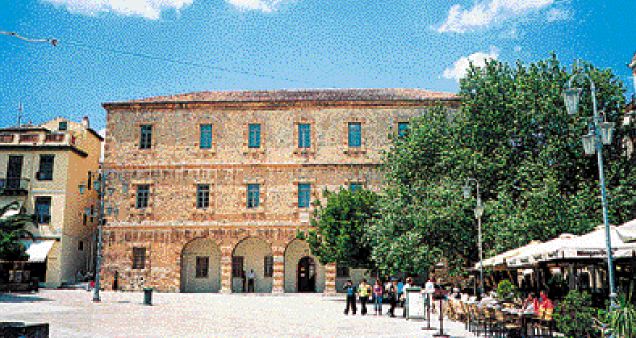 The Venetian Arsenale with its splendid arcade is one of the landmark buildings on the central Constitution Square |
We were disappointed to find out that the earliest we could pay a visit to the archaeological museum was in the beginning of 2007. This jewel of Venetian architecture on the Constitution Square is receiving an extensive facelift - floors, display cases, air-conditioning system, lighting, facilities for people with special needs - and a revamping of its collections and exhibit material. One of the museum's most precious holdings is the Suit of Mycenaean Armour, which was unearthed at Dendra in 1960. |
|
|
At the komboloi museum on Staikopoulou Street we learn about the various uses of worrybeads in different cultures: from the Hindus and Buddhists, who would use them as early as 560BC as a helping aid for counting prayers, to the Greeks beginning in the 18th century. Greece is the only country in the world that has never used it for religious purposes, but rather in order to achieve calm or gather one's thoughts. Founded by collector Aris Evangelinos in 1998, the museum, which sells handmade worrybeads and faithful copies, features items from 1700 to 1950 made of pure amber, mastic, ivory and red coral. Nafplio's classical music festival Nafplio is a summer magnet for classical music lovers, with a festival held here every June for the last 15 years under artistic director/pianist Yannis Vakarelis. This year, spotlighting Japanese culture and Mozart for the occasion of the 250th anniversary of the composer's birth, the international festival features on June 28 violinist Atsuko Watanabe and pianist Seiko Tsukamoto, who perform at Vouleftiko Takemitsu's Distance de Fee as well as works by Mozart, Pulenc and Franck. Lined up on the Japanese front, also at Vouleftiko, are exhibitions of kimono (June 23-July 2), ikebana floral arrangements (June 24), origami and calligraphy (on June 25 and July 2 respectively). For martial arts fans on July 1 Joshimura Kenichi and three of his students bring to Nafplio the samurai swordsmanship art of Kendo. Concerts paying tribute to Mozart include Berlin-based Petersen Quartet's performance (June 25 at Agios Yeorgios Square), which also features works by Brahms and Shostakovich; Wien Ensemble's concert (June 1 at Palamidi) with German soprano Marlis Petersen (she held the lead role in Megaron's staging of Lulu in 2005) in works by Mozart, Strauss and Lehar; and cellist Miklos Perenyi's concert (July 2 at Bourdzi) to the accompaniment of the Graz Philharmonic Chamber Orchestra in a programme which also includes works by Haydn and Bartok. Running through to July 2, the festival opens on June 23 with an opera evening at the Agios Yeorgios Square inspired by the Orpheus myth. On opening night, baroque group Latinitas Nostra will perform works by Scarlatti, Pergolesi, Fux and Sartorio to be followed on June 25 by an Athens State Orchestra concert. Greek Romanian soprano Marina Krilovic will perform arias and French chansons to the accompaniment of cellist Claire Demeulenaere and pianist Dimitris Yakas (June 26 at Vouleftiko) and Katia Paraschou's quartet all the way from the New School of New York's Mann College will present a programme of French and German composers. Also planned is a concert by the Gina Bachauer competition winners, pianists Sotiris Louizos and Evanelia Moutsopoulou (June 29 at Vouleftiko), and a tribute to composer Dimitris Terzakis, the German-based son of author Angelos Terzakis. Where to stay |
||
(Posting Date 8 July 2006) HCS readers can view other excellent articles by the Athens News writers and staff in many sections of our extensive, permanent archives, especially our News & Issues, Travel in Greece, Business, and Food, Recipes & Garden sections at the URL http://www.helleniccomserve.com./contents.html
All articles of Athens News appearing on HCS have been reprinted with permission. |
||
|
||
|
2000 © Hellenic Communication Service, L.L.C. All Rights Reserved. http://www.HellenicComServe.com |
||

